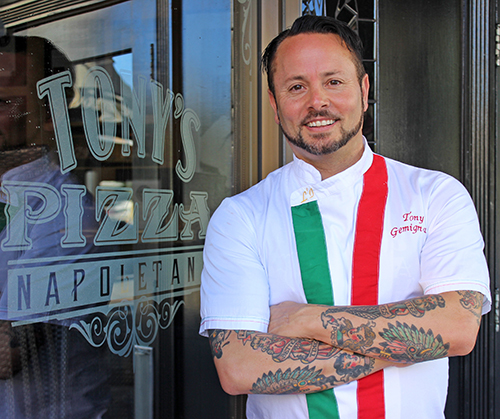It takes some audacity to call a cookbook The Pizza Bible, but author Tony Gemignani can back up his claim.
He’s a 12-time World Pizza Champion and Guinness world record-holding pizza-spinner. Customers line up at his five San Francisco pizzerias, where he serves a variety of styles, from a Neapolitan to coal-fired to by the slice; Gemignani also has two Pizza Rock locations in Sacramento and Las Vegas.
 Pizza is so ubiquitous — it’s on about a third of all menus in the U.S., according to the National Restaurant Association — but let’s face it, there is a lot of mediocre pizza out there. In his book, Gemignani covered nine Italian regional variations on this favorite, plus a number of American styles. He recently dished up some secrets to the perfect pie, especially without the benefit of a dedicated 900-degree pizza deck.
Pizza is so ubiquitous — it’s on about a third of all menus in the U.S., according to the National Restaurant Association — but let’s face it, there is a lot of mediocre pizza out there. In his book, Gemignani covered nine Italian regional variations on this favorite, plus a number of American styles. He recently dished up some secrets to the perfect pie, especially without the benefit of a dedicated 900-degree pizza deck.
Find the right flour. “Flour is the heart and soul of the pizza,” Gemignani says. Choosing the wrong flour is arguably the most common mistake chefs make. Often they opt for all-purpose, or hotel-style flour, which is not very strong and doesn’t stand up to high heat (the 900- to 1000-degree range). Others use a 00 flour, thinking because it’s from Italy it must be good. Those flours are designed for high temperatures, but standard commercial ovens are only set at 500-600 degrees. The result is a stale taste. Gemignani recommends a high-gluten/high-protein flour and browning agents (sugar, malt or honey). Without the agent, the pie won’t brown correctly, it will take too long to finish and the vegetable ingredients on the surface will start releasing water. Result: soggy pizza. Think bread flour is the answer? Think again. The higher protein levels result in a bready taste, and pizza should have its own flavor.
Cheese matters, too. Gemingnani likes whole-milk mozzarella. “It bakes better than part skim because of the higher butterfat content, has a better stretch and it’s more white than brown.”
What about the water? It’s worth taking an extra step for this third key component. “Why does New York pizza taste great? It’s not because the water is so flavorful – it’s what’s in the water and how clean it is. That allows the yeast to function better, the dough to stretch better and rise better.” Hard water makes the dough tough, inelastic and dull. He recommends using moderately hard to soft water, and if it’s not coming out of the tap that way, installing a filter.
Phase in ingredients. Neophyte chefs tend to pile on all the ingredients and shove a pizza in the oven. But some things are better left to the end. Parmesan, goat cheese and pepper, for instance, will retain their flavor better added after baking the pizza. Items like prosciutto and poblanos will look more pleasing if they haven’t been hit with high heat, too. “People think they have to have this giant make line. It’s more about using quality ingredients,” Gemignani says.





